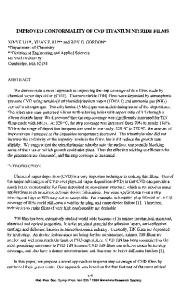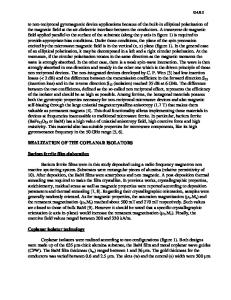Passive Films and Blistering of Titanium
- PDF / 1,898,524 Bytes
- 7 Pages / 388.08 x 610.56 pts Page_size
- 65 Downloads / 335 Views
ABSTRACT Coupons of titanium alloys under consideration as components of the Engineered Barrier System in the proposed repository at Yucca Mountain have been evaluatedfor their passive film composition and stability. Oxide depths and compositions on specimens exposed in long-term corrosion testing for one year were determined with x-ray photoemission spectroscopy. The specimens removed from long-term testing, as well as separate coupons polarized cathodically in an electrochemical cell, exhibited blistering associated with hydride formation in both scanning electron microscopy and atomic force microscopy.
INTRODUCTION Several commercial grades of titanium are currently under consideration as components of the packages being designed for containment of spent fuel and other high-level waste at the U.S. Monitored Geological Respository planned for Yucca Mountain, Nevada. Table 1 summarizes the compositions of the two titanium alloys investigated in this study. The addition of Pd to Titanium Grade 16 is believed to raise the corrosion potential of the alloy relative to that of unalloyed titanium. The addition of Mo in Titanium Grade 12 is indended to enhance the passivation of the alloy, while Ni is added to maintain
thermodynamic stability.
Table 1: Compositions of Commercial Grades 12 and 16 of Titanium. ASTM
C
Fe
H
N
0
Ti
Pd
Ni
2
Mo
Grade (max) (max) (max) (max) (max)
Residual Max Total
12
0.08
0.3 0.015
0.03 0.25 bal
16
0.08
0.3 0.015
0.03
0.6-0.9 0.2-0.4
0.3 bal 0.04-0.08
863 Mat. Res. Soc. Symp. Proc. Vol. 556 © 1999 Materials Research Society
0.4 0.4
These alloys were chosen for their known corrosion resistance, which is considered desirable for a containment application in a repository. Even so, titanium, a strong getter for hydrogen, is known to be susceptible to hydrogen embrittlement., We have therefore initiated a study of hydride formation and swelling in these alloys, employing Secondary Ion Mass Spectrometry (SIMS) to detect hydrogen bound in titanium hydride, and both scanning electron microscopy (SEM) and atomic force microscopy (AFM) to detect swelling and other morphological changes visible on the surface of these alloys following exposure to specific, corrosive conditions. Corrosion studies for the Yucca Mountain Site Characterization Project have emphasized crevice corrosion as an example of occluded geometries in which the corrosiveness of the electrolyte in the vicinity of the metal barrier might be expected to increase. The presence of crevices is inevitable in the repository. They appear, for example, between the layers of a multiple-layer containment vessel, between a containment vessel and its supports, and between the outer surface of a metal vessel and a silicate scale which may cover it. Under conditions in which oxygen diffusion into a crevice is impeded, metal inside
the crevice dissolves anodically, and halide ions migrate into the crevice to balance the resulting excess of positive charge from the titanium cations there. Titanium chlorides are unstable and
Data Loading...








